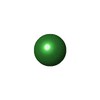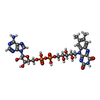+ Open data
Open data
- Basic information
Basic information
| Entry | Database: PDB / ID: 4ci0 | ||||||
|---|---|---|---|---|---|---|---|
| Title | Electron cryo-microscopy of F420-reducing NiFe hydrogenase Frh | ||||||
 Components Components | (F420-REDUCING HYDROGENASE, SUBUNIT ...) x 3 | ||||||
 Keywords Keywords |  OXIDOREDUCTASE / OXIDOREDUCTASE /  FLAVOPROTEIN / FLAVOPROTEIN /  ELECTRON TRANSFER / ELECTRON TRANSFER /  FERREDOXIN FERREDOXIN | ||||||
| Function / homology |  Function and homology information Function and homology information coenzyme F420 hydrogenase / coenzyme F420 hydrogenase /  coenzyme F420 hydrogenase activity / coenzyme F420 hydrogenase activity /  ferredoxin hydrogenase activity / ferredoxin hydrogenase activity /  iron-sulfur cluster binding / nickel cation binding / iron-sulfur cluster binding / nickel cation binding /  flavin adenine dinucleotide binding / 4 iron, 4 sulfur cluster binding flavin adenine dinucleotide binding / 4 iron, 4 sulfur cluster bindingSimilarity search - Function | ||||||
| Biological species |    METHANOTHERMOBACTER MARBURGENSIS (archaea) METHANOTHERMOBACTER MARBURGENSIS (archaea) | ||||||
| Method |  ELECTRON MICROSCOPY / ELECTRON MICROSCOPY /  single particle reconstruction / single particle reconstruction /  cryo EM / Resolution: 3.36 Å cryo EM / Resolution: 3.36 Å | ||||||
 Authors Authors | Allegretti, M. / Mills, D.J. / McMullan, G. / Kuehlbrandt, W. / Vonck, J. | ||||||
 Citation Citation |  Journal: Elife / Year: 2014 Journal: Elife / Year: 2014Title: Atomic model of the F420-reducing [NiFe] hydrogenase by electron cryo-microscopy using a direct electron detector. Authors: Matteo Allegretti / Deryck J Mills / Greg McMullan / Werner Kühlbrandt / Janet Vonck /  Abstract: The introduction of direct electron detectors with higher detective quantum efficiency and fast read-out marks the beginning of a new era in electron cryo-microscopy. Using the FEI Falcon II direct ...The introduction of direct electron detectors with higher detective quantum efficiency and fast read-out marks the beginning of a new era in electron cryo-microscopy. Using the FEI Falcon II direct electron detector in video mode, we have reconstructed a map at 3.36 Å resolution of the 1.2 MDa F420-reducing hydrogenase (Frh) from methanogenic archaea from only 320,000 asymmetric units. Videos frames were aligned by a combination of image and particle alignment procedures to overcome the effects of beam-induced motion. The reconstructed density map shows all secondary structure as well as clear side chain densities for most residues. The full coordination of all cofactors in the electron transfer chain (a [NiFe] center, four [4Fe4S] clusters and an FAD) is clearly visible along with a well-defined substrate access channel. From the rigidity of the complex we conclude that catalysis is diffusion-limited and does not depend on protein flexibility or conformational changes. DOI: http://dx.doi.org/10.7554/eLife.01963.001. | ||||||
| History |
|
- Structure visualization
Structure visualization
| Movie |
 Movie viewer Movie viewer |
|---|---|
| Structure viewer | Molecule:  Molmil Molmil Jmol/JSmol Jmol/JSmol |
- Downloads & links
Downloads & links
- Download
Download
| PDBx/mmCIF format |  4ci0.cif.gz 4ci0.cif.gz | 170.3 KB | Display |  PDBx/mmCIF format PDBx/mmCIF format |
|---|---|---|---|---|
| PDB format |  pdb4ci0.ent.gz pdb4ci0.ent.gz | 136.1 KB | Display |  PDB format PDB format |
| PDBx/mmJSON format |  4ci0.json.gz 4ci0.json.gz | Tree view |  PDBx/mmJSON format PDBx/mmJSON format | |
| Others |  Other downloads Other downloads |
-Validation report
| Arichive directory |  https://data.pdbj.org/pub/pdb/validation_reports/ci/4ci0 https://data.pdbj.org/pub/pdb/validation_reports/ci/4ci0 ftp://data.pdbj.org/pub/pdb/validation_reports/ci/4ci0 ftp://data.pdbj.org/pub/pdb/validation_reports/ci/4ci0 | HTTPS FTP |
|---|
-Related structure data
| Related structure data |  2513MC M: map data used to model this data C: citing same article ( |
|---|---|
| Similar structure data |
- Links
Links
- Assembly
Assembly
| Deposited unit | 
|
|---|---|
| 1 | x 12
|
| 2 |
|
| 3 | 
|
| Symmetry | Point symmetry: (Schoenflies symbol : T (tetrahedral : T (tetrahedral )) )) |
- Components
Components
-F420-REDUCING HYDROGENASE, SUBUNIT ... , 3 types, 3 molecules ABC
| #1: Protein | Mass: 42696.773 Da / Num. of mol.: 1 / Fragment: RESIDUES 1-386 / Source method: isolated from a natural source Source: (natural)    METHANOTHERMOBACTER MARBURGENSIS (archaea) METHANOTHERMOBACTER MARBURGENSIS (archaea)References: UniProt: D9PYF9,  coenzyme F420 hydrogenase coenzyme F420 hydrogenase |
|---|---|
| #2: Protein | Mass: 30267.762 Da / Num. of mol.: 1 / Source method: isolated from a natural source Source: (natural)    METHANOTHERMOBACTER MARBURGENSIS (archaea) METHANOTHERMOBACTER MARBURGENSIS (archaea)References: UniProt: D9PYF7,  coenzyme F420 hydrogenase coenzyme F420 hydrogenase |
| #3: Protein | Mass: 30778.752 Da / Num. of mol.: 1 / Source method: isolated from a natural source Source: (natural)    METHANOTHERMOBACTER MARBURGENSIS (archaea) METHANOTHERMOBACTER MARBURGENSIS (archaea)References: UniProt: D9PYF6,  coenzyme F420 hydrogenase coenzyme F420 hydrogenase |
-Non-polymers , 6 types, 9 molecules 










| #4: Chemical | ChemComp-FE /  Iron Iron | ||||
|---|---|---|---|---|---|
| #5: Chemical | ChemComp-NI /  Nickel Nickel | ||||
| #6: Chemical | ChemComp-FE2 / | ||||
| #7: Chemical | ChemComp-SF4 /  Iron–sulfur cluster Iron–sulfur cluster#8: Chemical | ChemComp-ZN / | #9: Chemical | ChemComp-FAD / |  Flavin adenine dinucleotide Flavin adenine dinucleotide |
-Details
| Nonpolymer details | ZINC ION (ZN): A ZINC ION IS SHARED BY TWO FRHG SUBUNITS |
|---|---|
| Sequence details | THE SEQUENCE AFTER HIS386 HAS BEEN REMOVED BY AN ENDOPEPTID |
-Experimental details
-Experiment
| Experiment | Method:  ELECTRON MICROSCOPY ELECTRON MICROSCOPY |
|---|---|
| EM experiment | Aggregation state: PARTICLE / 3D reconstruction method:  single particle reconstruction single particle reconstruction |
- Sample preparation
Sample preparation
| Component | Name: F420 REDUCING HYDROGENASE / Type: COMPLEX |
|---|---|
| Buffer solution | Name: 50MM TRIS-HCL, 0.025MM FAD / pH: 7.6 / Details: 50MM TRIS-HCL, 0.025MM FAD |
| Specimen | Conc.: 0.7 mg/ml / Embedding applied: NO / Shadowing applied: NO / Staining applied : NO / Vitrification applied : NO / Vitrification applied : YES : YES |
| Specimen support | Details: HOLEY CARBON |
Vitrification | Instrument: FEI VITROBOT MARK I / Cryogen name: ETHANE Details: VITRIFICATION 1 -- CRYOGEN- ETHANE, HUMIDITY- 70, TEMPERATURE- 103, INSTRUMENT- FEI VITROBOT MARK I, METHOD- BLOTTING 2.5 SECONDS BEFORE PLUNGING, |
- Electron microscopy imaging
Electron microscopy imaging
| Experimental equipment |  Model: Tecnai Polara / Image courtesy: FEI Company |
|---|---|
| Microscopy | Model: FEI POLARA 300 / Date: May 27, 2013 / Details: DATA WAS COLLECTED IN MOVIE MODE |
| Electron gun | Electron source : :  FIELD EMISSION GUN / Accelerating voltage: 300 kV / Illumination mode: FLOOD BEAM FIELD EMISSION GUN / Accelerating voltage: 300 kV / Illumination mode: FLOOD BEAM |
| Electron lens | Mode: BRIGHT FIELD Bright-field microscopy / Nominal magnification: 78000 X / Calibrated magnification: 106000 X / Nominal defocus max: 2500 nm / Nominal defocus min: 800 nm / Cs Bright-field microscopy / Nominal magnification: 78000 X / Calibrated magnification: 106000 X / Nominal defocus max: 2500 nm / Nominal defocus min: 800 nm / Cs : 2.2 mm : 2.2 mm |
| Specimen holder | Temperature: 79 K |
| Image recording | Electron dose: 22 e/Å2 / Film or detector model: FEI FALCON II (4k x 4k) |
| Image scans | Num. digital images: 235 |
| Radiation wavelength | Relative weight: 1 |
- Processing
Processing
| EM software |
| ||||||||||||
|---|---|---|---|---|---|---|---|---|---|---|---|---|---|
CTF correction | Details: EACH IMAGE | ||||||||||||
| Symmetry | Point symmetry : T (tetrahedral : T (tetrahedral ) ) | ||||||||||||
3D reconstruction | Method: MAXIMUM LIKELIHOOD / Resolution: 3.36 Å / Num. of particles: 26000 / Nominal pixel size: 1.32 Å / Actual pixel size: 1.32 Å / Magnification calibration: FIT TO ATOMIC MODEL Details: FRH IS A FRHABG DODECAMER WITH TETRAHEDRAL SYMMETRY. SUBMISSION BASED ON EXPERIMENTAL DATA FROM EMDB EMD-2513. (DEPOSITION ID: 12073). Symmetry type: POINT | ||||||||||||
| Atomic model building | Protocol: FLEXIBLE FIT / Space: REAL / Details: METHOD--FLEXIBLE REFINEMENT PROTOCOL--CRYO-EM | ||||||||||||
| Atomic model building | PDB-ID: 3ZFS | ||||||||||||
| Refinement | Highest resolution: 3.36 Å | ||||||||||||
| Refinement step | Cycle: LAST / Highest resolution: 3.36 Å
|
 Movie
Movie Controller
Controller








 PDBj
PDBj

















